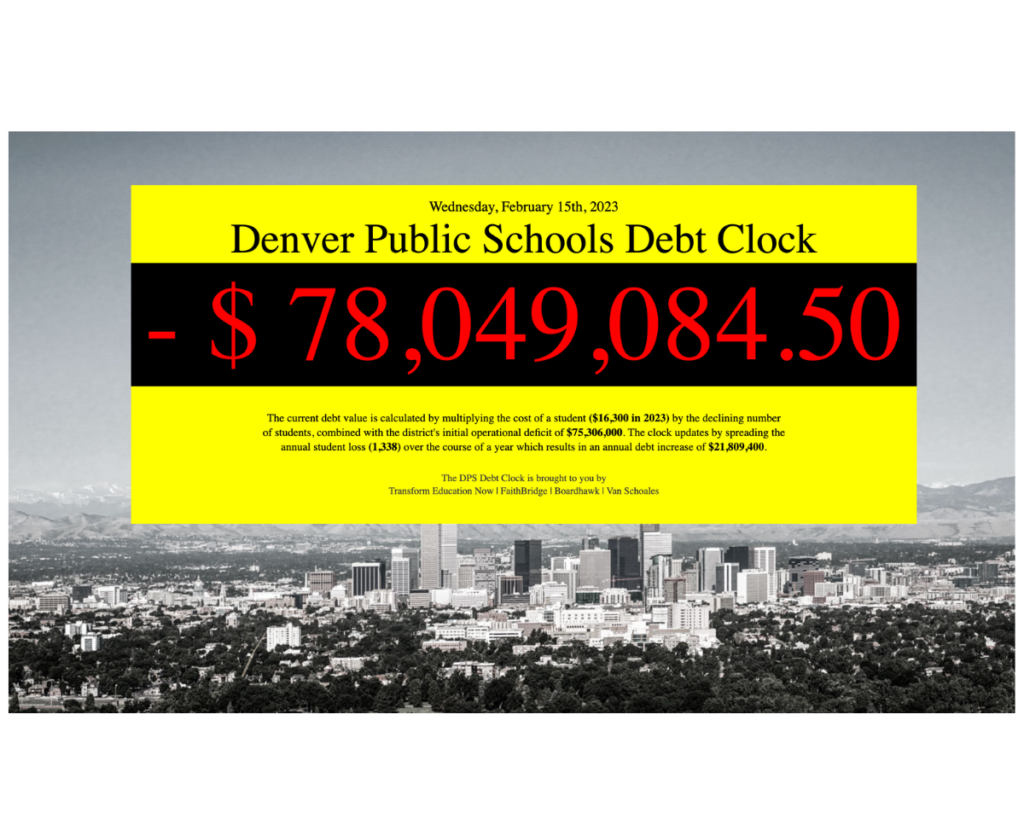The new Denver Public Schools Debt Clock website, debuting today, serves as a stark reminder that postponing important decisions for political reasons can be costly -– literally as well as figuratively.
A consortium of advocacy groups, individual advocates, and Boardhawk have joined forces to present this website to the public so that the public can demand better of the people it elected to oversee the operations of Colorado’s largest school district.
When Denver’s school board decided to hold off on closing schools because of declining enrollment, its members made a conscious decision to place the district in a precarious financial position, at least in the short-term. But that decision potentially has long-term impact on the overall operations of the district and therefore impact on the learning of students.
While board members were rightly concerned that district leadership had failed to involve the community in closure recommendations, the decision ultimately must be made by the board, and will undoubtedly make some school communities unhappy.
Meanwhile, the clock ticks inexorably on, penny by penny, dollar by dollar, etc.
Let’s review the context. School districts across the country are experiencing declining enrollment, especially in urban areas. Urban districts, including Denver, will experience significant drops in enrollment because of declining birthrates, decreasing immigration, and shifting demographics in America’s cities.
During the previous decade, Denver experienced dramatic student growth compared to nearly all other urban school school districts across the country. The city was growing as Green Valley Ranch and Central Park continued to be built out.
At the same time, the Denver Preschool Program and development of new schools succeeded in capturing a higher percentage of the existing student population in Denver. But the city is now more fully built out, birth rates are dropping, and young families are being priced out of the urban core.
The result: District enrollment has declined over the past few years, and will continue to do so for the foreseeable future..
There are many school districts that are addressing the declining enrollment challenge by closing schools. Jeffco has implemented the boldest plan – closing 16 elementary schools at the end of this school year to right-size their budget and provide more effective and efficient services to their students.
DPS Superintendent Alex Marrero initially proposed late last year closing 10 schools at the end of the current school year to address the district’s steadily declining enrollment. When board members balked, saying Marrero and his team had failed to seek community input, Marrero dropped the number to five, then two.
Ultimately the board rejected closing any schools unless and until the district embarked on a community engagement process. Almost three months have passed, and there is no sign that any schools will be closing at year’s end.
Looking forward it is clear that the district must address its surplus of schools yet the question remains how? One answer could be to revisit the DPS School Performance Compact which evaluated schools and provided a meaningful framework to make tough decisions associated with school closures. The compact outlined a school, staff and community engagement for all schools identified through the policy.
However the district decides to tackle the issue one thing is clear, that it must do so with urgency and should do so in a way that prioritizes the learning and academic progress of students.
This failure to act has significant budgetary implications for the district, and we hope the debt clock will provide the public with a stark reminder of that fact.
The current structural deficit means that ultimately there will be fewer teachers and less instructional time for students. And the costs of instruction will grow as the costs of maintaining underutilized buildings increase, and the number of students continues to drop over time.
How does our debt clock work, and where do the numbers come from? Student enrollment, enrollment projections and spending levels can be found in a variety of presentations from the Denver Public Schools finance presentations here.
The DPS clock is a simple calculation created by multiplying the cost of a student ($16,300 in 2023) by the declining number of declining students. The clock changes by the second by spreading the annual student loss (1,338) over the course of a year which results in a total loss per year of $21,809,400. The cost per second rounds to $1.
The school simply can’t postpone tough decisions indefinitely. Time waits for no one, and time is money, to combine two clichés.
The debt clock simply illustrates the truth in those statements.
The DPS Debt Clock is brought to you by Transform Education Now, Boardhawk, Vernon Jones Jr., and Van Schoales.




